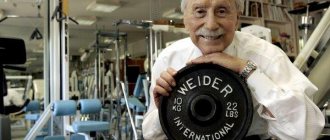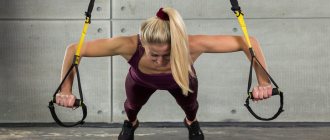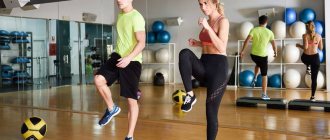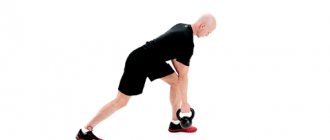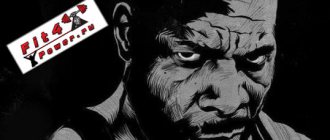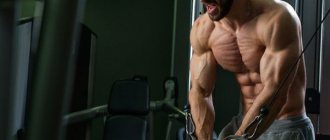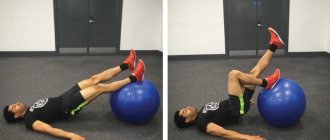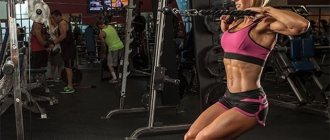Women's bodybuilding is popular among athletes of different levels. Many girls and women dream of doing it in order to take part in competitions, demonstrating their achievements to others. In fact, it is not as simple as it seems at first glance. After all, not every man can withstand such serious training, and it’s not worth talking about the fairer sex. This requires a certain physical preparation, as well as willpower and spirit, without which it is simply impossible to achieve results.
The article will tell you more about women's bodybuilding. Before and after reading this information, girls' goals for playing sports may suddenly change. After all, playing such sports has many features that few people know about. The most important thing to remember is that it’s never too late to start taking care of yourself, and even if at the moment your physical capabilities do not allow you to start hard training, you need to approach this gradually. By doing something every day that leads to your goal, you will soon be able to achieve what you want.
Evaluation of mandatory poses for men (bodybuilding, classic bodybuilding)
Changes in required poses
Since 2015, at the proposal of the IFBB Executive Committee, minor changes have been approved in the mandatory poses relating to the categories “men's bodybuilding” and “classic bodybuilding”.
1. “Front double biceps”
Standing facing the judges, move one leg forward to the side by 40-50 cm, the participant must raise both arms to shoulder level and bend them at the elbows. The hands should be clenched into fists and turned down. This will tighten the muscles in your biceps and forearms, which are the main muscle groups assessed in this pose. In addition, the competitor must strive to tense as many muscles as possible as the judges evaluate the entire body. The judge will first look at the biceps muscles, paying attention to the peak of the biceps, its shape, and continuing to look at the development of the forearms, deltoids, abs, thighs and legs. The judge will look for muscle density, definition and balance.
2. “Latissimus dorsi in front” - Front lat spread
Standing facing the judges, placing the feet in one line at a distance of 15 cm from each other, the athlete must place his hands, preferably clenched into fists, on the lower part of the waist and “straighten” the latissimus dorsi muscles. The athlete should try to tense the muscles of the chest, arms, and abs. It is strictly forbidden to pull your swimming trunks too tight. The judge must first evaluate whether the athlete was able to show the “span” of the latissimus muscles, creating a torso in the shape of the Latin letter “V”. The judge should then evaluate the entire pose from head to toe, as in Pose 1, noting the general aspects first and then concentrating on looking in more detail at the various muscle groups.
3. “Biceps on the side” - Side chest
To demonstrate his best biceps, the athlete must turn his left or right side towards the judges, bend the arm closest to the judges at a right angle (with a clenched fist), and grab the wrist of the bent arm with the other. The leg closest to the judges bends at the knee and stands on the toe. The athlete tenses the chest and biceps, and also tenses the thigh muscles, in particular the biceps (flexor) group of the thigh and, by applying downward pressure with the foot on the toe, demonstrates the tension of the calf muscles. In this case, the judge must evaluate the entire pose “from head to toe.”
4. “Back double biceps”
The athlete must turn his back to the judges, bend his arms and, as in the double biceps position, put his foot back, resting on his toes, and then tense the muscles of the arms, as well as the shoulders, back, thighs and calves. The judge must first pay attention to the arm muscles, and then evaluate the entire pose from head to toe. It evaluates many more muscle groups than all other poses, including the neck, deltoids, biceps, triceps, forearms, trapezius, back extensors, external obliques, lats, glutes, hamstrings, and calves. This pose is likely more than any other to help determine the quality of an athlete's muscle density, definition, and overall balance of the physique.
5. “Latissimus dorsi muscles from behind” - Back lat spread
The athlete must, standing with his back to the judges, place his hands on his waist, keeping his elbows wide. Place your feet in one line at a distance of 15cm from each other. He then tightens and “spreads” the latissimus dorsi as wide as possible and shows the tension in these muscles, as well as in the hips and calves, by pressing down on the toe of the back foot. It is strictly forbidden to pull your swimming trunks too tight. The judge must evaluate not only the "reach" of the latissimus dorsi muscles, but also good transverse density and then evaluate the entire pose from head to toe.
6. Side triceps
The athlete can choose either side for this pose to show off the triceps of their best arm to the judges. He must turn his left or right side towards the judges and place both hands behind his back. He can either clasp his fingers or grab the wrist of his “front” hand with his “back” hand. The “front” leg closest to the judges must be bent at the knee and resting on the toes. In this case, the athlete forces the triceps muscles to tense. It also lifts the chest and tightens the abdominal muscles, as well as the thigh and calf muscles. The judge must first look at the triceps and then evaluate the entire pose from head to toe. In this position and in the side biceps position, the judge should view the thigh and calf muscles in profile, which will help him assess the development of these muscles more accurately.
7. “Abs thigh” – Abdominals and thighs
Facing the judges, the athlete must place both hands behind his head and put his foot forward or place his feet in one line at a distance of 15 cm from each other. Then he should tighten his abdominal muscles while simultaneously tightening his thigh muscles. The judge must evaluate the abdominal and thigh muscles, as well as the entire pose from head to toe.
And this is how they should look:
Information from Pawel FILLEBORN, Chairman Judges Commitee IFBB. Pay attention to the placement of the legs in the poses:
- A/ Front double biceps
- B/ Front lat spread
- D/Back double biceps
- E/Back lat spread
***POSES FOR BOTH BODYBUILDING AND CLASSICAL BODYBUILDING
***POSES ARE REQUIRED SINCE 2015
ERRORS IN POSITIONING:
Fitness bikini
- Feminine figure
- Harmoniously developed muscle groups
- Distinctive features: the “standard” are rounded buttocks, flat stomach, thin waist (and the thinner it is, the better)
- The chosen image (hairstyle, makeup, jewelry) is of great importance; as for the swimsuit, the athlete is given a huge choice. Basic requirements: the bottom should cover 2/3 of the buttocks. The bodice usually has a large push-up to beautifully highlight the bust
- Particular attention is paid to presentation - smoothness of gait, graceful hand movements, gaze, transitions between poses and, of course, self-confidence, charisma and energy with which the athlete performs (by the way, and not only in the bikini category). It often happens that the form may leave much to be desired, but thanks to charisma and correct presentation, the athlete will be rated by the judges with a higher score.
Judging women's competitions (bodybuilding)
The judging procedure must be the same as for men, including weigh-in.
The Chief Judge has the right to inspect any competitor's costume at the pre-competition weigh-in and during the competition to ensure that the costume complies with IFBB rules: bikini bottoms must cover 1/2 of the buttocks, and the use of shiny, brocade or printed fabric in the costume is strictly prohibited.
1. Assessment of mandatory poses for women:
- "Double biceps front"
- "Biceps side"
- "Double biceps at the back"
- "Triceps side"
- "Abs thigh"
2. Assessment of women's build:
All 5 compulsory poses for women are performed and judged in the same way as for men, however, first of all, the judge must remember that he is judging a competition of female bodybuilders and choosing the ideal female figure. Therefore, the most important aspect is the muscular female form. Other aspects are similar to those recorded for the evaluation of men, but as far as muscle development is concerned, it should not be excessive, similar to the massive muscularity of men. A woman's muscle definition should not be confused with exhaustion resulting from excessive weight loss. When assessing, judges must take into account other defects such as: skin breaks, cellulite. Judges must also evaluate the gracefulness of a woman's gait and posing, which, unlike a man's, lasts 90 seconds, tables of judges' marks, statistical sheets of those counting, and other documents - the same as in men's competitions. The awards ceremony for women should be the same as for men.
Calf raises
You can work your calves quite effectively using calf raises. Here it is recommended to use a barbell for weighting. It, as in squats, should be placed on the shoulders. To perform the exercise, you will need a hill on which you can stand with your toes.
As you exhale, you need to rise on your toes, and as you inhale, return back, lowering your heels as low as possible. It is very important to keep your balance here, as there is a risk of falling from a height due to the barbell. It's best to try doing lifts without additional weight first (just a couple of sets).
Posing in bodybuilding. Basic competitive poses in bodybuilding
Today we’ll talk about posing in bodybuilding, as a mandatory element of any competition in this sport. It’s not enough to grow big muscles, properly dry your body and make your muscles sculpted. You also need to show your achievements in competitions. Therefore, the possible success on them depends on the quality of posing.
At least five weeks before the competition, you need to start mastering bodybuilding poses. If you treat it carelessly, it can cost you a victory. Therefore, it is worth dedicating an hour a day to posing.
Standard exercises
You shouldn’t even think about competing in women’s bodybuilding if all of the exercises listed below cannot be performed with the correct technique. Doing this, of course, will not be so easy the first time, but over time everything will definitely work out. The weight for each of them is selected individually, so following the technique is not so difficult. Exercises must be performed in 3 sets of 12-15 times. At the same time, in each approach it is necessary to increase the working weight. Although the difference between them is minimal, it should still be there.
Each workout should begin with a warm-up. You can use a treadmill or bicycle as it, and only after that you are allowed to start a full-fledged workout. The complex includes only those exercises that work well on a specific muscle group.
Competition poses in bodybuilding[edit | edit code ]
With five weeks left before a competition, bodybuilders have to make significant changes to their training program. If everything is in order with training and diet, then the next most important point is mastering the mandatory poses. These are the poses that every athlete should be able to achieve so that judges can compare him with others - and this is a true art. A careless attitude towards this component of professional bodybuilding can cost the athlete victory.
It is advisable to pay attention to posing every day, especially before competitions.
Left “Double biceps front”, right “Latissimus dorsi front”
On the left is “Side Biceps”, on the right is “Back Double Biceps”
On the left “Latissimus dorsi muscles behind”, in, on the right “Abs thigh”
Competitive posing round
– athletes are divided into groups and each group is asked to come forward from the line of participants, calling out numbers. After which, the selected athletes are asked to take several mandatory positions in turn.
If there are few competitors in a category of athletes, they are not divided into groups, but are asked to take compulsory positions immediately after the proportions comparison round. Depending on the number of participants in the category and the competition regulations, the number of rounds of competitive posing can be one or more (quarterfinals, semifinals, finals).
Free program round
– athletes take turns on the podium, and each shows his personal program, to the accompaniment of music. During this round, the bodybuilder may assume any competition position, mandatory or optional. Elements of dance are possible, adding elements such as splits or somersaults. The use of additional accessories and items (such as glasses, gloves, clothing items, etc.) is not permitted. Usually, the duration of a free program according to the competition rules is no more than one minute, but in some cases exceptions are allowed (during bright commercial shows they sometimes pose for several minutes).
Federation
The most popular bodybuilding federations in the world are:
- The IFBB is the largest international federation today that holds tournaments in the United States. In our country, the interests of this organization are represented by the FBI. The most famous competition from the IFBB is “Olympia” - a spectacular battle of “mass monsters”.
- NABBA is another international federation, but smaller and less well-known.
- WBFF is a high-status organization of an international format with a developed element of entertainment and show at tournaments. In women's disciplines, fancy costumes are allowed, and a fashion show in dresses is also a mandatory element.
- NBS is a federation on a Russian scale. It differs from the rest in open judging, payment of compensation for trips to international competitions, and the presence of a separate nomination for posing.
In addition to these, there are dozens of smaller organizations.
Relaxed pose [edit | edit code ]
The mandatory posing begins with a relaxed pose facing the judges, followed by four 90-degree turns. In a relaxed position, it is important to always keep your chest high, your shoulders and lats fully extended, and your arms and legs tense. Ideally, all this should be done with a smile or at least without a grimace of pain on your face. Each quarter turn is always done to the right—never to the left. The first turn is done to show the judges the left side of the body, the next another quarter turn to show the back, another quarter turn to show the right side and finally the last one to face the judges again.
Turn in a military manner, moving your right leg back and then turning your left. While rehearsing, gradually learn to make smooth and relaxed movements. The position facing the judges sideways is one of the most difficult because it makes almost everyone look “skinny”, not as massive as they do from the front or back. Therefore, you need to learn to look as massive as possible in it.
In the first quarter turn, with your left side facing the judges, place your left leg slightly in front of your right, this will allow your lower body to look wider and more solid. Turn your left knee slightly inward to better show your left hamstring to the judges. In addition, the judges will also see part of the right leg, which will add depth to the lower body; the left leg should not be placed too far in front of the right. The left heel should be close to the arch of the right foot - no further. Don't rise up on your toes. The judges pay strict attention to this. If they see that you are stepping too far forward, they may reprimand you.
Important points [edit | edit code ]
The abdominal muscles need to be kept tight - this is one of the most important aspects of the pose sideways to the judges. If the stomach is relaxed, this will be noted immediately. But if you hold your stomach, then no problems will arise. Posing is hard work, so you will need stamina. If you start breathing heavily, it will immediately become noticeable in your stomach. Therefore, practice to train your body to accept any pose with easy breathing. In the side pose, the chest should be raised high and the shoulders should be slightly turned towards the judges. This will improve the impression of the figure. Remember that at the same time as your shoulders, you must slightly bend your left knee and turn it inward, away from the judges. This will create the necessary tension and rotation in the waist, and will also help keep the stomach tucked in. The next thing is to tense your left arm, and if you have large pectoral muscles, contract your right arm while turning your shoulders towards the judges. Repeat the same in the pose with your right side facing the judges. When you turn your back, the elements of the pose will be the same as in the full face, that is, chest raised high, arms extended and arms tense. Also be sure to tighten your hamstrings and calves instead of your quadriceps, which won't be visible. Also, tighten your triceps more than your biceps.
Nutrition
Female bodybuilding is inherently a process of burning subcutaneous fat, as well as building muscle mass. It will not be possible to achieve certain results through training alone. On the way to the long-awaited effect, you will encounter many difficulties, one of which is changing your diet. It will not be drastic, but stress for the body will be provided in any case. Therefore, you should immediately prepare yourself mentally for such actions so as not to suddenly break down.
First of all, you need to understand that nutrition should be balanced. The diet must include foods high in minerals, vitamins, and nutrients. In addition, there are several more important rules:
- Portions should not be too large.
- After physical activity, the body should receive food that fills it with energy.
- You should forget about sweets and baked goods.
- The morning should always start with carbohydrates, that is, cereals.
Poses facing the judges [edit | edit code ]
This includes five mandatory poses:
- double biceps in front;
- widest in front;
- abs (arms above head);
- HP;
- quadriceps.
The front double biceps is a classic bodybuilding pose [edit | edit code ]
It is clear that the key muscles here are the biceps. There are many options here, but Arnold's style is recognized as classic. The legs should be tense to show the definition of the hips. The abdominal muscles are drawn in, but not tense, the chest is raised high, and the shoulder sections of the arms are parallel to the floor. The biceps should be reduced as much as possible, but you should also look relaxed and smile. Some athletes raise their elbows higher. This version was brought into fashion by Steve Reeves, and Lee Haney did the same - there should be no comments from the judges in this case.
Latissimus anterior [ edit | edit code ]
This pose demonstrates the width of your shoulders and the size of your latissimus dorsi muscles. It is very important here not to strain your chest too much. Instead, keep your chest as high as possible and your shoulders as back as possible. Franco Colombo brought his elbows forward and contracted his pectoral and abdominal muscles. This is an acceptable option if the chest is thick enough, but the most important thing here is to keep the chest and shoulders as high and wide as possible.
Press [edit | edit code ]
They will definitely ask you to put your hands behind your head and contract your abdominal muscles. The most important thing here is to exhale as much air as possible and contract your abs as hard as you can. Don't forget that your legs are very visible in this pose because you're facing the judges the entire time—so contract your quads, too.
HP [edit | edit code ]
HP
– a pose in which you show the overall thickness, development and degree of separation of the chest, shoulders and arms. Here it is important to calculate exactly where the hands will be in relation to the body. In general, the weaker the chest and shoulders look, the further away the arms should be from the body, and vice versa. This is one of the most difficult poses because it requires many muscles to contract at once, but it is a favorite among spectators and judges use it to judge an athlete's overall form.
Quadriceps [edit | edit code ]
This is not a required pose, but judges may ask to see it. It is performed, of course, while facing the audience. Hands are usually placed on the hips or rested on the sides. The upper body should be relaxed without losing abdominal control. Step one leg forward and contract your muscles tightly. Some people like to effectively shake their quadriceps before contracting. This is acceptable for athletes with large muscle mass.
Squats
Women's bodybuilding includes the favorite barbell squat. They are performed in the same way as regular ones, but you need to use a bar as a weighting agent, placing it on your shoulders behind your head.
During the exercise, the head should be kept straight. You need to go down while inhaling, and go up while exhaling. At the lowest point, the thighs should be parallel to the floor, and when lifting, be sure to watch your back so that it does not lean forward, as this can lead to injury.
Poses with your back to the judges [edit | edit code]
There are four mandatory poses here:
- double biceps at the back;
- latissimus posterior;
- caviar;
- thigh biceps.
Back double biceps [edit | edit code]
This is almost the same as a "front double biceps" but some muscles need to be emphasized. This pose shows not so much the development of the biceps, but rather the thickness and detail of the back. Therefore, the elbows need to be pulled back a little to contract the muscles of the upper back and rear deltoids. The loin should be slightly arched to show the separation known as herringbone. And don't forget to tighten your hamstrings and calves.
Lat rear[edit | edit code]
Latissimus rear
– this pose demonstrates the width of the back. It’s not the thickness that’s important here, but the width, so try to spread your lats out to the sides as much as possible.
Hamstrings/Calves [ edit | edit code]
This pose is not always called, but may be asked to show the hamstrings and calves from behind separately. The hamstrings are shown by raising the heel towards the gluteals, and the calves are shown by standing on the toes. There are no specific standards, and not every panel of judges will ask you to do this pose, but it's worth practicing just in case.
Content
- 1 Competition poses in bodybuilding
- 2 Relaxed posture 2.1 Important points
- 3.1 Double biceps front classic bodybuilding pose
- 4.1 Double biceps back
- 5.1 Side chest
Poses sideways to the judges [edit | edit code ]
There are two of these:
Side chest [ edit | edit code ]
Side chest
– this pose begins by lifting one leg and placing it on the toe. You then turn your knee away from the judges to better show them your hamstrings. At the same time, place your palms together under your chest (the arm being demonstrated is from below), lift your chest as high as possible, slightly tense the pectoral muscle that you are not demonstrating, and lean one shoulder towards the judges. There should be no gap between the arms and torso. And finally, tense your hand towards the judges, turn your gaze towards them and smile.
Triceps side view [ edit | edit code ]
Triceps side view
– in this position, you also put your foot on your toes, turn your knee inward, showing the hamstring biceps to the judges, and at the same time clasp your hands behind your back. Straighten and tighten the triceps of the arm facing the judges, lift your chest and draw in your stomach. A little trick you can use here is to “support” the triceps with the latissimus dorsi muscle. Keep your head straight, look at the judges and don't forget to smile!
Weight loss
What will help you lose excess weight more effectively than bodybuilding? Women's fitness is actually one of the most effective ways to lose weight. Therefore, having decided to get rid of hated fat deposits with the help of sports, you should start doing bodybuilding. It helps to always keep muscles toned and prevents them from relaxing.
When exercising on simulators and strictly controlling the intensity of training, the muscles will gradually become stronger. At the same time, blood flow will increase, energy will begin to be produced, and fat, in turn, will begin to disappear.
Bodybuilding can work wonders. They contribute to a change in posture, the appearance of muscle relief, and an improvement in well-being. Thanks to them, every lady will be able to tighten her buttocks, chest, and abs, thereby making her body proportional.
Posing in bodybuilding
To compete in competitions, bodybuilders need several years of hard training in the gym to shape their figure. This is a very responsible and difficult period, but sooner or later the moment comes for which so many hours were spent in the hall. The athlete believes that he is ready and enters the tournament.
But, even with a magnificent figure, you have to show yourself beautifully to the jury and the audience. It should be remembered here that it is always not a specific muscle group or muscle that is evaluated, but the entire athlete as a whole. Even little things like your stance and movement can be the deciding factor in winning. Thus, the impression of an athlete's performance depends on posing in bodybuilding.
Many athletes underestimate this factor and completely in vain. In bodybuilding, it is not a specific indicator of strength or endurance that is assessed, but rather the aesthetic appearance of athletes. Many people criticize bodybuilding for its possible bias, but we have what we have and every athlete who wants to achieve victories should master posing in bodybuilding.
Most bodybuilders cannot take high places only because of their inability to present themselves to the audience. When moving along the catwalk, they may lose their balance or take poses that are not able to highlight the beauty of their figure. A bodybuilder's body can be compared to a piece of art. It is not for nothing that in ancient times sculptors paid so much attention to the human body. Of course, the idea of an ideal figure has changed since then, but that’s not the point.
Pay attention to the performances of bodybuilding stars, and you will find that each athlete has his own signature poses that delight the audience. By and large, most of these poses are known to everyone, but you need to find something special to attract the attention of the jury and the public. Although some athletes come up with poses on their own.
Equally important is the ability to vary poses. Thanks to one of them, you can beautifully show not only the part of the body for which it is intended, but also other muscles or muscle groups. Let's say one pose can demonstrate the power of your back, while another can emphasize its symmetry. With the right choice of pose, you can skillfully hide flaws and demonstrate the advantages of your figure.
When choosing poses for performance, you should approach this process creatively. Each of them must look impressive and artistic. By using the right pose, you can show the audience the parts of your body that they need to see. We can safely say that posing in bodybuilding is a real art that cannot be learned. But without this it is almost impossible to become a champion.
Fitness
- Athletes in this category have smaller muscle volumes compared to the previous category
- High demands on body contour
- In addition to posing, a free program (gymnastics or dance) is mandatory, which also allows you to evaluate the athlete’s plasticity and grace
I especially liked Oksana Grishina’s program at the Arnold Classic in 2016, where she took first place.

